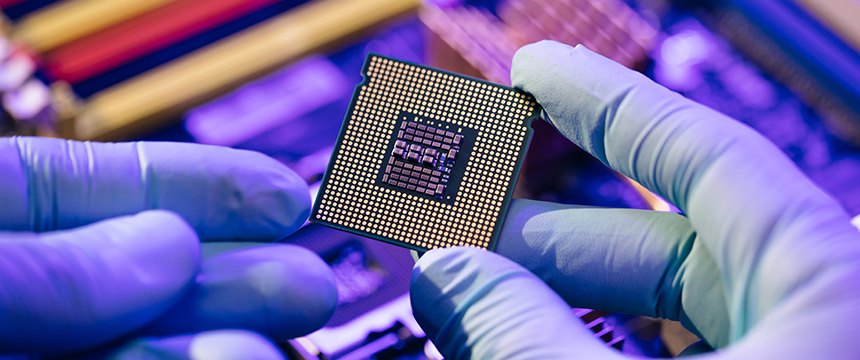Automation, Electrification, and Connectivity: The Auto Industry in the ITC
Auto Trends Series: Article 5

Automakers and their suppliers have long been participants in unfair trade investigations before the International Trade Commission (“ITC”), but the scope and subject matter of automotive-related investigations is evolving. Trends in the automotive industry—including automation, artificial intelligence, electrification, connectivity, and advanced security—are increasing automotive industry participation (direct and indirect) in ITC investigations involving less conventional automotive technology areas. This is particularly evident in recent ITC investigations involving semiconductor chips. Below we explore this shift in approach to ITC investigations involving automotive technologies and the complexities involved when the investigation relates to, e.g., semiconductor chip technology rather than conventional automotive technology areas involving mechanical and electromechanical inventions.
The core of these investigations remains the same—i.e., the ITC evaluates the injury to a domestic industry by an alleged statutory violation or other unfair act, but the semiconductor chip as a component of the imported automotive article is a newer target and implicates new issues. Semiconductor and related integrated circuit technology is typically embedded deep within modern vehicles and their component parts. There are dozens of such chips, typically designed and specified by suppliers and manufactured and distributed pursuant to unique global supply chain relationships. Understanding the unique nature of these trade relationships, the semiconductor technology at issue, and the objectives of the ITC is critical to successful prevention and defense of these investigations.
I. ITC Investigations, Generally
Section 337 of the Tariff Act of 1930 (as amended) (19 U.S.C.§ 1337) authorizes the ITC to issue an injunction in the form of an exclusion order. The exclusion order is issued to U.S. Customs and Border Protection (“CBP”) to exclude articles from entry into the United States that either violate U.S. based intellectual property (“IP”) rights or otherwise constitute an unfair act that injures a domestic industry in the U.S. The first type of investigation involves statutory IP claims and includes, e.g., copyrights, trademarks, and, most commonly, patents. The second type of investigation involves other unfair acts, including, e.g., trade secret misappropriation. The key distinctions between the ITC and a district court in either type of investigation is the ITC’s ability to issue an exclusion order (prevent unfair importation) and its inability to award money damages.
In an ITC investigation involving a patent infringement claim (most common) as well as other statutory IP claims, the complainant must satisfy the ITC’s unique two-prong domestic industry requirement, which involves proof of separate economic and technical prongs. The economic prong generally considers the complainant’s or its licensees’ domestic investment in plant or equipment, labor or capital, or research and development. These domestic investments must be significant or substantial to meet the ITC’s threshold economic prong requirement. The technical prong generally considers whether the claimed investments pertain to material protected by the IP right. Thus, in addition to proving that the respondent’s imported article infringes the patent, the complainant must prove its domestic industry article practices the patent.
II. ITC Investigations Involving Automotive Components
The ITC is no stranger to disputes involving automotive components. But investigations in the automotive space historically focused on importation of mechanical and electromechanical articles, ranging from such components as tires, wheels, headlamps, engines, transmissions; to security systems, control systems, infotainment systems. These investigations primarily involved disputes between respective Tier 1 and Tier 2 suppliers, and at times implicated the automakers themselves. Table 1 appended to this article identifies exemplary investigations relating to importation of traditional mechanical and electromechanical automotive articles.1
An example of an investigation that involved a mechanical/electromechanical automotive article and traditional automotive industry issues is Certain Windshield Wipers and Components Thereof, Inv. No. 337-TA-928. In the 928 Investigation,2 the complainant automotive part supplier alleged infringement by another automotive part supplier of patents directed to windshield wiper technology, particularly devices for detachably linking a wiper blade with a driven wiper arm.3
The respondent denied infringing any asserted patent and raised other common defenses in statutory IP cases at the ITC, including, inter alia, that the patent was invalid and that the complainant failed to prove existence of a domestic industry.4 During claim construction, the parties disputed basic terms like “securing section,” “locking sections,” “seat,” and “wiper blade assembly,” among others.5 The Administrative Law Judge’s (“ALJ’s”) initial determination addressed these common ITC defenses and issues.6
With respect to infringement, the ALJ considered the parties’ positions with respect to certain critical claim limitations and found some claims infringed, and others not.7 The ALJ’s analysis evaluated basic mechanical features of the accused products relative to the claims at issue, and was not overly complex.8
With respect to invalidity, the ALJ considered the parties’ positions with respect to two prior art wiper blade assemblies that respondents argued the complainants sold commercially prior to the critical date of the asserted patents (and thus were subject to the “on sale”/“public use” bar under pre-AIA 35 U.S.C. § 102(b)).9 Again, the technical analysis proved relatively straightforward. The ALJ concluded that the first prior art wiper blade assembly was structurally similar, but not proven to be functionally identical, to the accused products in respects relevant to the patent claims at issue.10 The ALJ concluded that the respondent failed to prove that the second prior art wiper blade assembly was in public use or on sale prior to the critical date of the asserted patents, and thus was not actually prior art.11
With respect to domestic industry, the ALJ determined that the complainant had proven significant investments in both labor and capital and plant and equipment sufficient to meet the economic prong of the domestic industry requirement.12 Separate from the conventional allocation and summation of creditable investments within these categories, at issue was whether the complainant could credit investments in the entire wiper blade assembly, or rather should be limited to crediting investments only in the patented blade and arm portion (and not in unpatented portions like wiper motors and linkages).13 The ALJ’s technical prong analysis was consistent with the infringement analysis, and not overly complex.14
The dispute over the scope of the domestic industry “article” is common in ITC investigations. To address the issue, the ITC developed the “realities of the marketplace” doctrine, which permits the domestic industry “article,” in certain circumstances, to extend beyond the patented article itself to downstream articles incorporating the patented article, i.e., wiper blade assemblies incorporating patented blade/arm portions.15
In the 928 Investigation, the majority of the complainant’s customers were OEMs who purchased complete wiper blade assemblies (including motors and linkages), rather than solely the patented blade/arm portions.16 Because non-patented components like motors and linkages were thus necessary to exploit the patented technology, the ALJ concluded that the appropriate domestic industry “article” was the entire wiper blade assembly, and complainant could credit domestic industry investments accordingly.17 It is typically in the complainant’s interest to expand the scope of the domestic industry “article” in order to capture a broader group of investments for purposes of proving the significance or substantiality of its investments.
Another aspect of the 928 Investigation that is historically relevant to the automotive industry was the respondent’s repair doctrine defense.18 The repair doctrine is commonly used in patent cases implicating aftermarket technology as a form of patent exhaustion, where the patent owner’s exclusionary rights “exhaust” at sale such that the purchaser has the right to maintain/repair the product at issue and doing so is not infringement.
Given the secondary markets in vehicles and their replaceable components, the repair doctrine is often applied in patent cases involving aftermarket automotive technologies, and one of the Supreme Court’s seminal decisions addressing the doctrine arose in that context.19 In the 928 investigation, the ALJ determined the was repair doctrine was not applicable to one of the asserted patents because the accused infringer was not merely replacing a worn out component of the patented wiper blade assembly, but was replacing the entire assembly itself.20
As the 928 Investigation demonstrates, the ITC is familiar with investigations involving mechanical and electromechanical automotive technologies (and related conventional claim construction, infringement, and invalidity analyses), as well as automotive industry issues like the “repair” doctrine and how the “realities of the [automotive] marketplace” might affect the domestic industry analysis. Automakers and their suppliers are likely also familiar with these mechanical and electromechanical technologies and related automotive industry issues. But as automotive technology evolves and gets increasingly complex, so do the issues addressed in the related ITC investigations.
III. Automotive Industry Demand for Semiconductor Chips, Generally
Vehicle technological developments are now increasingly centered on computerized systems, such as automation, electrification, digital connectivity, infotainment systems, and advanced security. The proliferation in the number of patents being issued in these spaces has led, in turn, to automakers and their suppliers being increasingly targeted by patent infringement lawsuits involving these technologies (in both district courts and the ITC).
The expected acceleration of semiconductor ITC investigations in the automotive industry is resulting, in part, from the rapid growth of the global semiconductor chip industry more broadly. Semiconductor sales are expected to reach nearly $700 billion (US) in revenue by the end of 2023 and $1 trillion in revenue by 2030 (doubling in the decade).21 A recent report by Deloitte focusing on the automotive industry’s demand for semiconductor chips touts its fast-growing demand, estimating that it accounts for approximately 12% of total global semiconductor demand.22
During the 2017-2022 time period, the automotive industry used semiconductors in over 50 types of factory-installed electronics, which generally fell within eight categories and grew at the following rates: advanced driver-assistance systems (ADAS): 23.6%; EV/HEV: 21%; body: 13.3%; instrument cluster: 11.2%; infotainment: 8.2%; chassis: 6.2%; aftermarket: 6.1%; powertrain: 3.4%; and safety: 2.6% (with a reported mean of 7.2%).23 The report explained the industry’s increasing demand, in part, as follows:
Consumption of automotive electronic components for safety, infotainment, navigation and fuel efficiency will increase for years to come due to ever-more electronic components being applied in advanced safety features added to vehicles. Among applications driving semiconductor growth, advanced driver-assistance systems (ADAS) will have the largest increase. They will drive demand for ICs (Integrated Circuits), MCUs and sensors.24
Deloitte concluded, “[f]our mega trends will result in more semiconductor content being added to automotive electronics and subsystems in the next decade”; namely, automation, electrification, digital connectivity, and advanced security.25 As components and semiconductors for these subsystems become increasingly important and prevalent, the likelihood of patent disputes and other ITC-based investigations increases.
IV. ITC Investigations Involving Semiconductor Chips
As a historically foreign manufactured article (over 60% of all semiconductor chips were manufactured in East Asia in 2020),26 the ITC has been an available enforcement option for owners of semiconductor and related technology patents for many years, and the potential for an exclusion order has made it an attractive venue. While the United States has recently made a concerted effort to localize semiconductor chip manufacture, foreign manufacture is expected to continue in mainstays like Taiwan and South Korea, and increasingly in other countries like China, Japan, Singapore, Israel, and throughout Europe.27 Table 2 appended to this article identifies recent Investigations relating to importation of semiconductor devices.28
Recent Investigations involving semiconductor chips have named automakers among the respondents. In Certain Power Inverters and Converters, Vehicles Containing the Same, and Components Thereof, Inv. No. 337-TA-1267, the complainant alleged Section 337 violations by certain automakers, without naming Tier 1 and 2 suppliers, regarding certain power inverters and converters and vehicles and components incorporating them.29 The complainant alleged the patented technology “enables automotive manufacturers . . . to add 48-volt electrical systems to their latest vehicles in order to implement, for example, mild-hybrid systems with advanced ‘start-stop’ and/or power recuperation functions, as well as other high power load vehicle components such as anti-roll stabilization systems, electronic turbo chargers, or even air conditioner compressors.”30
Respondents denied infringing the asserted patents and raised other defenses, including, inter alia, that the patent was invalid, and that the complainant failed to prove existence of a domestic industry.31 During claim construction, the parties disputed terms like “input signal of the current amplifier,” “regulate the offset to a minimum,” and “regulating the offset to a minimum.”32 The claim construction analysis was highly complex, relying on the testimony of experts in the fields of semiconductor structure, design, imaging, characterization, and fabrication, as well as textbooks covering the design of microelectronic circuits.33
With respect to infringement, the ALJ considered the parties’ positions and concluded that the complainant failed to prove that the accused semiconductor chips met certain claim limitations.34 The ALJ’s analysis analyzed highly complex circuit schematics and related expert testimony, and in some instances required complex analysis of semiconductor chip structure, including review of images created using scanning electron microscopy (“SEM”) and transmission electron microscopy (“TEM”) methods.35
With respect to invalidity, the ALJ considered the parties’ positions with respect to certain prior art references, separately and in combination, and concluded that many of the asserted patents were invalid.36 The ALJ’s analyzed highly complex circuit schematics found in certain U.S. and Japanese patent publications and relied extensively on the testimony of experts in the fields of semiconductor structure, design, imaging, characterization, and fabrication in her assessment.37
With respect to domestic industry, the ALJ determined that the complainant had proven significant investments in labor and capital with respect to one patent, but not the other.38 In determining the complainant failed to prove the economic prong with respect to the one patent, the ALJ found the complainant’s economic expert reliably apportioned the creditable labor and capital investments, but failed to show that they were significant in any context.39 The ALJ’s technical prong analysis was consistent with the infringement analysis.40
Another example of a recent investigation involving semiconductor chips and named automakers is Certain Semiconductor Devices and Products Containing the Same, Including Printed Circuit Boards, Automotive Parts, and Automobiles, Inv. No. 337-TA-1332. In the 1332 Investigation, the complainant alleged Section 337 violations by certain automakers and Tier 1 and 2 suppliers through the sale for importation, importation, and/or the sale within the United States after importation of automotive infotainment systems, “including those that utilize semiconductor chipsets.”41 Notably, the ITC declined to institute the Investigation as to certain automakers and Tier 1 suppliers because the complainant failed to sufficiently describe within the complaint and exhibits the specific instances of importation or sale for those respondents.42
Other recent Investigations involving semiconductor chips and related technologies name only Tier 1 and 2 suppliers, not the automakers.43
Nonetheless, as automakers continue to incorporate advances technologies into their vehicles, including in areas like automation, artificial intelligence, electrification, digital connectivity, and advanced security, they can expect to be increasingly drawn into these more recent broad and technically complex investigations. Potentially relevant vehicle automation includes things like active cruise control and lane departure warning systems; parking and lane assist; automatic emergency braking, driver monitoring, and traffic jam assist; sensor fusion and auto pilot.44 Electrification includes hybrid electric vehicles (“HEV”) or electric vehicles (“EV”).45 Digital connectivity includes things like incorporation of internet of things (“IoT”), in-dash operating systems, and vehicle-to-vehicle and vehicle-to-infrastructure communication systems.46 Advanced security includes things like situational awareness, and associated braking, acceleration, and crash avoidance systems, as well as elements of cybersecurity.47 Each of these technology areas requires increasing numbers of electronic components—from high-speed processors, to memory, microcontrollers, sensors, and data links.
V. Proactive Measures to Consider
While no one can affirmatively predict the automotive industry’s future at the ITC, recent automotive industry and ITC trends relating to automation, electrification and connectivity suggest that as more advanced electrical systems are added to everyday vehicles, automakers and automotive suppliers can expect to increasingly be subject to ITC investigations involving semiconductor chips and related technologies. For potential respondents, strategic proactive measures can be taken to reduce the likelihood of being subject to such an investigation and/or the associated risk. These measure might include, for example, assuring domestic manufacture and assembly of certain vehicle and vehicle components, minimizing external identification of semiconductor technology in vehicles, and/or considering contractual allocation of risk within supplier relationships. All these measures are admittedly easier said than done.
Should your company become involved in an ITC proceeding—either as a complainant or as a defendant—you will need to be prepared to present a case that explains not only the technology, but also the breadth and nature of domestic and foreign vehicle manufacturing and component supply chain and assembly. We have found that successful pursuit or defense in an ITC proceeding requires: (i) knowledge of the common contractual relationships involved in these complex and (often) international networks; (ii) understanding of the design, manufacture, supply, assembly, importation, inventory, and ultimate use of the relevant technology; and (iii) understanding of the potential impact an exclusion order may have on the relevant supply chain to the extent a violation is found, which may be relevant to the ITC’s assessment of whether an exclusion order will have an adverse impact on the public interest.48 You also will want to be prepared to navigate enforcement outcomes where continued interaction with U.S. CBP and the ITC may be required to define the scope of the exclusion order.49
Defense of these Investigations thus requires technical semiconductor expertise, experience with the ITC and its proceedings, and industry knowledge regarding complex automotive supply chain relationships and international trade. The authors of this article can help automakers and automotive suppliers navigate the ITC and the issues raised in this article if they become involved in a Section 337 investigation concerning semiconductors or other automotive components.
Table 1—Exemplary Investigations Relating to Importation of Automotive Articles
|
Investigation No. |
Title |
|
337-TA-1353 |
Certain Pick-Up Truck Folding Bed Cover Systems and Components Thereof (III) |
|
337-TA-1345 |
Certain Automated Retractable Vehicle Steps and Components Thereof |
|
337-TA-1322 |
Certain Rotating LIDAR Devices, Components Thereof, and Sensing Systems Containing the Same |
|
337-TA-1292 |
Certain Replacement Automotive Lamps II |
|
337-TA-1291 |
Certain Replacement Automotive Lamps |
|
337-TA-1235 |
Certain Vehicle Control Systems, Vehicles Containing the Same, and Components Thereof |
|
337-TA-1188 |
Certain Pick-up Truck Folding Bed Cover Systems and Components Thereof |
|
337-TA-1173 |
Certain Rotating 3-D LiDAR Devices and Products Containing the Same (Including Autonomous Vehicles, Unmanned Aerial Vehicles, Industrial Machines, and Robotics), and Components Thereof |
|
337-TA-1152 |
Certain Vehicle Security and Remote Convenience Systems and Components Thereof |
|
337-TA-1140 |
Certain Multi-Stage Fuel Vapor Canister Systems and Activated Carbon Components Thereof |
|
337-TA-1119 |
Certain Infotainment Systems, Components Thereof, and Automobiles Containing the Same |
|
337-TA-1073 |
Thermoplastic-Encapsulated Electric Motors, Components Thereof, and Products and Vehicles Containing the Same |
|
337-TA-1052 |
Thermoplastic-Encapsulated Electric Motors, Components Thereof, and Products and Vehicles Containing the Same |
|
337-TA-1042 |
Hybrid Electric Vehicles and Components Thereof |
|
337-TA-1006 |
Passenger Vehicle Automotive Wheels |
|
337-TA-1000 |
Motorized Self-Balancing Vehicles |
|
337-TA-998 |
Hybrid Electric Vehicles and Components Thereof |
|
337-TA-964 |
Windscreen Wipers and Components Thereof |
|
337-TA-954 |
Variable Valve Actuation Devices and Automobiles Containing the Same |
|
337-TA-937 |
Windshield Wipers and Components Thereof |
|
337-TA-928 |
Windshield Wipers and Components Thereof |
|
337-TA-907 |
Vision-Based Driver Assistance System Cameras and Components Thereof |
|
337-TA-899 |
Vision-Based Driver Assistance System Cameras and Components Thereof |
|
337-TA-894 |
Computing or Graphics Systems, Components Thereof, and Vehicles Containing the Same |
|
337-TA-816 |
Wiper Blades |
|
337-TA-814 |
Automotive GPS Navigation Systems, Components Thereof, and Products Containing Same |
|
337-TA-755 |
Starter Motors and Alternators |
|
337-TA-722 |
Automotive Vehicles and Designs Thereto |
|
337-TA-688 |
Hybrid Electric Vehicles and Components Thereof |
|
337-TA-657 |
Automotive Multimedia Display and Navigation Systems, Components Thereof, and Products Containing Same |
|
337-TA-651 |
Automotive Parts |
|
337-TA-585 |
Engines, Components Thereof, and Products Containing Same |
|
337-TA-561 |
Combination Motor and Transmission Systems and Devices Used Therein, and Products Containing Same |
|
337-TA-557 |
Automotive Parts |
|
337-TA-540 |
Automotive Grilles |
|
337-TA-532 |
Automotive Fuel Caps and Components Thereof |
|
337-TA-355 |
Vehicle Security Systems and Components Thereof |
|
337-TA-334 |
Condensers, Parts Thereof and Products Containing Same, Including Air Conditioners for Automobiles |
|
337-TA-319 |
Automotive Fuel Caps and Radiator Caps and Related Packaging and Promotional Materials |
|
337-TA-207 |
Automotive Transmission Shifters |
|
337-TA-117 |
Automotive Visors |
|
337-TA-102 |
Wheel Locks and Components Thereof |
Table 2—Exemplary Investigations Relating to Importation of Semiconductor Devices
|
Investigation No. |
Title |
|
337-TA-1350 |
Certain Integrated Circuits, Components Thereof, and Products Containing the Same |
|
337-TA-1342 |
Semiconductor Devices Having Layered Dummy Fill, Electronic Devices, and Components Thereof |
|
337-TA-1340 |
Certain Electronic Devices, Semiconductor Devices, and Components Thereof |
|
337-TA-1335 |
Certain Integrated Circuits, Mobile Devices Containing the Same, and Components Thereof |
|
337-TA-1336 |
Semiconductor Devices, Mobile Devices Containing the Same, and Components Thereof |
|
337-TA-1332 |
Certain Semiconductor Devices and Products Containing the Same, Including Printed Circuit Boards, Automotive Parts, and Automobiles |
|
337-TA-1319 |
Electronic Devices and Semiconductor Devices with Timing-Aware Dummy Fill and Components Thereof |
|
337-TA-1308 |
Certain Power Semiconductors, and Mobile Devices and Computers Containing Same |
|
337-TA-1295 |
Certain Integrated Circuit Products and Devices Containing the Same |
|
337-TA-1287 |
Integrated Circuits, Chipsets, and Electronic Devices, and Products Containing the Same |
|
337-TA-1272 |
Integrated Circuits and Products Containing the Same |
|
337-TA-1267 |
Power Inverters and Converters, Vehicles Containing the Same |
|
337-TA-1254 |
Certain Semiconductor Devices, Wireless Infrastructure Equipment Containing the Same, and Components Thereof |
|
337-TA-1246 |
Certain Integrated Circuits and Products Containing the Same |
|
337-TA-1177 |
Certain Semiconductor Devices, Products Containing the Same, and Components Thereof (II) |
|
337-TA-1176 |
Certain Semiconductor Devices, Products Containing the Same, and Components Thereof (I) |
|
337-TA-1149 |
Certain Semiconductor Devices, Integrated Circuits, and Consumer Products Containing the Same |
|
337-TA-1148 |
Certain Integrated Circuits and Products Containing the Same |
|
337-TA-1080 |
Water-Level Packaging Semiconductor Devices and Products Containing Same (Including Cellular Phones, Tablets, Laptops, and Notebooks) and Components Thereof |
|
337-TA-1047 |
Semiconductor Devices and Consumer Audiovisual Products Containing the Same |
|
337-TA-1024 |
Integrated Circuits with Voltage Regulators and Products Containing Same |
|
337-TA-1010 |
Semiconductor Devices, Semiconductor Device Packages, and Products Containing Same |
|
337-TA-984 |
Computing or Graphics Systems, Components Thereof, and Vehicles Containing Same |
Subscribe to the Auto Trends 2023 Series
For an ongoing discussion of where the industry is going, we invite you to subscribe to this Auto Trends 2023 Series by clicking here.
1 See Table 1. Investigations listed in Table 1 were identified using custom searches of Docket Navigator® case profiles.
2 The investigation was consolidated sua sponte with co-pending Investigation No. 337-TA-937. Some Respondents settled prior to the evidentiary hearing and were terminated from the investigation.
3 Certain Windshield Wipers and Components Thereof, Inv. No. 337-TA-928, Complaint at 1, 4 (USITC July 25, 2014).
4 E.g., Certain Windshield Wipers and Components Thereof, Inv. No. 337-TA-928, Answer at 21-27 (USITC Sept. 29, 2014).
5 Certain Windshield Wipers and Components Thereof, Inv. No. 337-TA-928, Markman Order at 3 (USITC Mar. 30, 2015).
6 See generally Certain Windshield Wipers and Components Thereof, Inv. No. 337-TA-928, ID (USITC Nov. 22, 2015).
7 Id. at 33-61.
8 See id.
9 Id. at 61-77.
10 Id. at 64-71.
11 Id. at 71-77.
12 Id. at 11-23.
13 Id. at 15-18.
14 Id. at 23-25.
15 See, e.g., Certain Video Game Systems and Wireless Controller and Components Thereof, Inv. No. 337-TA-7770, Comm’n Op. at 66 (USITC Oct. 28, 2013).
16 Certain Windshield Wipers and Components Thereof, Inv. No. 337-TA-928, ID at 16-17.
17 Id.
18 Certain Windshield Wipers and Components Thereof, Inv. No. 337-TA-928, Order at 8-13 (USITC May 19, 2015).
19 See, e.g., Aro Mfg. Co. v. Convertible Top Replacement Co., 365 U.S. 336 (1961).
20 Certain Windshield Wipers and Components Thereof, Inv. No. 337-TA-928, Order at 8-13.
21 Q2 2022 Semiconductor market forecast, World Semiconductor Trade Statistics, August 2022, available at https://www.wsts.org/76/103/The-World-Semiconductor-Trade-Statistics-WSTS-has-released-its-new-semiconductor-market-forecast-generated-in-August-2022 (last accessed Mar. 21, 2023); 2023 Semiconductor Industry Outlook, Deloitte (2023), at 7, available at https://www2.deloitte.com/us/en/pages/technology-media-and-telecommunications/articles/semiconductor-industry-outlook.html (last accessed Mar. 21, 2023).
22 Semiconductors – The Next Wave, Deloitte (2019), at 6, available at https://www2.deloitte.com/tw/en/pages/technology-media-and-telecommunications/articles/semiconductor-next-wave.html (last accessed Mar. 21, 2023) [hereinafter Deloitte 2019].
23 Deloitte 2019 at 7, 113.
24 Deloitte 2019 at 8.
25 Deloitte 2019 at 17.
26 Deloitte 2019 at 6.
27 2022 Semiconductor Industry Outlook, Deloitte (2022), at 6, available at https://www2.deloitte.com/za/en/pages/technology-media-and-telecommunications/articles/semiconductor-industry-outlook.html (last accessed Mar. 21, 2023).
28 See Table 2. Investigations listed in Table 2 were identified using custom searches of Docket Navigator® case profiles.
29 Certain Power Inverters and Converters, Vehicles Containing the Same, and Components Thereof, Inv. No. 337-TA-1267, Complaint at 12 (USITC May 21, 2021).
30 Id.
31 Certain Power Inverters and Converters, Vehicles Containing the Same, and Components Thereof, Inv. No. 337-TA-1267, ID at 31-118, 135-198 (USITC Aug. 12, 2022).
32 Id. at 20-31, 121-22.
33 See id.
34 Id. at 31-56, 135-59.
35 See id.
36 Id. at 77-118, 178-98.
37 Id.
38 Id. at 64-77, 159-78.
39 Id. at 159-78.
40 Id. at 56-64, 159-78.
41 Certain Semiconductor Devices and Products Containing the Same, Including Printed Circuit Boards, Automotive Parts, and Automobiles, Inv. No. 337-TA-1332, Complaint at 11 (USITC Aug. 23, 2022).
42 Certain Semiconductor Devices and Products Containing the Same, Including Printed Circuit Boards, Automotive Parts, and Automobiles, Inv. No. 337-TA-1332, Letter at 1 (USITC Oct. 7, 2022) (“The complaint alleges a violation of section 337(a)(1)(B) based upon “[t]he importation into the United States, the sale for importation, or the sale within the United States after importation by the owner, importer, or consignee, of articles that— (i) infringe a valid and enforceable United States patent . . . .” 19 U.S.C. § 1337(a)(1)(B)(i). The information provided with the complaint, supplement, and exhibits, however, does not sufficiently describe the specific instances of importation or sale for the foregoing respondents. 19 C.F.R. § 210.12(a)(3). The Commission has determined to institute an investigation with respect to the remaining proposed respondents.”).
43 See, e.g., Electronic Devices and Semiconductor Devices with Timing-Aware Dummy Fill and Components Thereof, Inv. No. 337-TA-1319 (USITC) (accusing certain semiconductor chip manufactures and their integrators of Section 337 violations, including at least one automotive microcontroller device integrated within an audio signal processor of a vehicle imported into the United States by an automaker, but not naming the automaker as a respondent); Certain Electronic Devices, Semiconductor Devices, and Components Thereof, 337-TA-1340 (USITC) (accusing certain semiconductor chip manufactures and their integrators of Section 337 violations, including with regard to an automotive microcontroller, but not naming automakers as respondents).
44 Deloitte 2019 at 18.
45 Deloitte 2019 at 19.
46 Deloitte 2019 at 19.
47 Deloitte 2019 at 19.
48 See, e.g., Hickerson, The Public Interest, EPROMs, and Domestic Industry Issues in Component Manufacturer S. 337 Investigations (Mar. 26, 2018), available at https://www.foley.com/en/insights/publications/2018/03/the-public-interest-eproms-and-domestic-industry-i (last accessed Mar. 21, 2023).
49 See, e.g., Roush et al., Navigating the Range of Remedial Orders at the ITC (July 26, 2022), available at https://www.foley.com/en/insights/publications/2022/07/navigating-range-remedial-orders-itc (last accessed Mar. 21, 2023).




